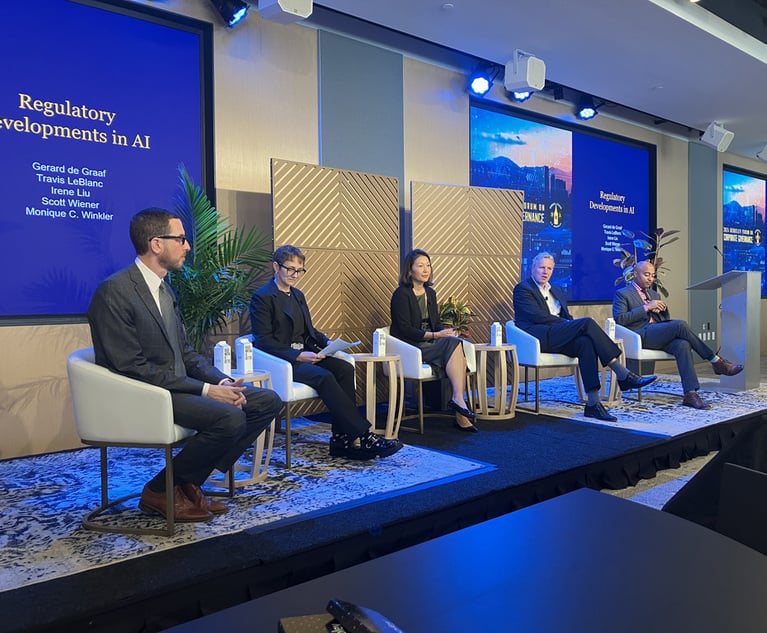7 tips for starting information governance projects
One general counsel recently told me he would rather change a tire in the rain than work on a records management project.
February 21, 2012 at 05:46 AM
3 minute read
The original version of this story was published on Law.com
This article is the part one of a seven part series on successful information governance projects.
One general counsel recently told me he would rather change a tire in the rain than work on a records management project. I can understand his reluctance. Considering the tar pit of corporate compliance, records management, litigation readiness, data privacy, e-mail retention and other information governance projects have a tendency to get stuck.
Follow these tips to avoid getting caught in the muck:
1. Don't get stuck before you start: The timing never seems to be quite right for starting these projects. “We are in the middle of litigation, and as soon as that is over we can start,” “We need to wait for the new budget cycle” and “We are waiting on IT” are reasons for not starting. Yet most organizations realize, years later, that the timing is never right. One AGC recently stated: “We finally realized that the timing would never be perfect. We would never not be involved in some litigation. Other groups would never be ready. We realized we had to drive the project, as well as drive funding. Otherwise we would be waiting forever.”
2. Determine what is in and out of scope: These projects can be very narrow in scope, such as updating the records retention schedule, or fairly expansive, driving enterprise-wide archiving and litigation readiness, for example. Decide what is in and out of scope at the beginning, and stick to it.
3. Create a long term roadmap: One information governance project often begets another. E-discovery can drive data mapping which in turn can drive IP strategies. Take a big picture view early through a long term roadmap. Decide which pieces you will do this year and which in subsequent years.
4. Don't proceed without senior management support: Effective information governance requires senior management support across multiple groups. Don't execute projects without this support, otherwise you will not get very far. Don't assume senior management will “become wise” and halfway through suddenly buy in to your initiative.
5. Break it into pieces: Information governance is too complex to execute as a single project, and any such attempt is likely to run out of gas before finishing. Break these into smaller projects, with a defined and socialized benefit at the end of each piece. Rack up a series of little wins to build momentum.
6. Bring in outside assistance, but own your programs in the end – While many corporate legal initiatives can be executed with internal resources, the multidisciplinary nature of information governance projects makes it difficult for companies to execute these projects totally alone. Consider bringing in help. (Full disclosure: Contoural provides consulting services for information governance.) At the same time, while assistance in building programs can be helpful, companies should ultimately plan on running their own programs. Don't build in dependencies from outside vendors such as law firms to run part of your program on an ongoing basis.
7. Discuss who will own in the long run – Information governance is a hot potato passed from one group to the next, or dropped on the floor. Early on in the project, discuss eventual roles and responsibilities.
Despite these challenges, many companies are executing effective, compliant and defensible information governance programs, even across large and complex organizations.
The next article in the series will discuss key yet often overlooked members of your information governance committee.
This content has been archived. It is available through our partners, LexisNexis® and Bloomberg Law.
To view this content, please continue to their sites.
Not a Lexis Subscriber?
Subscribe Now
Not a Bloomberg Law Subscriber?
Subscribe Now
NOT FOR REPRINT
© 2024 ALM Global, LLC, All Rights Reserved. Request academic re-use from www.copyright.com. All other uses, submit a request to [email protected]. For more information visit Asset & Logo Licensing.
You Might Like
View All
Fatal Shooting of CEO Sets Off Scramble to Reassess Executive Security
5 minute read
Ben & Jerry’s Accuses Corporate Parent of ‘Silencing’ Support for Palestinian Rights
3 minute read
Shareholder Activists Poised to Pounce in 2025. Is Your Board Ready?

Regulatory Upheaval Is Coming. How Businesses Prepare and Respond Will Separate Winners and Losers
Trending Stories
- 1Call for Nominations: Elite Trial Lawyers 2025
- 2Senate Judiciary Dems Release Report on Supreme Court Ethics
- 3Senate Confirms Last 2 of Biden's California Judicial Nominees
- 4Morrison & Foerster Doles Out Year-End and Special Bonuses, Raises Base Compensation for Associates
- 5Tom Girardi to Surrender to Federal Authorities on Jan. 7
Who Got The Work
Michael G. Bongiorno, Andrew Scott Dulberg and Elizabeth E. Driscoll from Wilmer Cutler Pickering Hale and Dorr have stepped in to represent Symbotic Inc., an A.I.-enabled technology platform that focuses on increasing supply chain efficiency, and other defendants in a pending shareholder derivative lawsuit. The case, filed Oct. 2 in Massachusetts District Court by the Brown Law Firm on behalf of Stephen Austen, accuses certain officers and directors of misleading investors in regard to Symbotic's potential for margin growth by failing to disclose that the company was not equipped to timely deploy its systems or manage expenses through project delays. The case, assigned to U.S. District Judge Nathaniel M. Gorton, is 1:24-cv-12522, Austen v. Cohen et al.
Who Got The Work
Edmund Polubinski and Marie Killmond of Davis Polk & Wardwell have entered appearances for data platform software development company MongoDB and other defendants in a pending shareholder derivative lawsuit. The action, filed Oct. 7 in New York Southern District Court by the Brown Law Firm, accuses the company's directors and/or officers of falsely expressing confidence in the company’s restructuring of its sales incentive plan and downplaying the severity of decreases in its upfront commitments. The case is 1:24-cv-07594, Roy v. Ittycheria et al.
Who Got The Work
Amy O. Bruchs and Kurt F. Ellison of Michael Best & Friedrich have entered appearances for Epic Systems Corp. in a pending employment discrimination lawsuit. The suit was filed Sept. 7 in Wisconsin Western District Court by Levine Eisberner LLC and Siri & Glimstad on behalf of a project manager who claims that he was wrongfully terminated after applying for a religious exemption to the defendant's COVID-19 vaccine mandate. The case, assigned to U.S. Magistrate Judge Anita Marie Boor, is 3:24-cv-00630, Secker, Nathan v. Epic Systems Corporation.
Who Got The Work
David X. Sullivan, Thomas J. Finn and Gregory A. Hall from McCarter & English have entered appearances for Sunrun Installation Services in a pending civil rights lawsuit. The complaint was filed Sept. 4 in Connecticut District Court by attorney Robert M. Berke on behalf of former employee George Edward Steins, who was arrested and charged with employing an unregistered home improvement salesperson. The complaint alleges that had Sunrun informed the Connecticut Department of Consumer Protection that the plaintiff's employment had ended in 2017 and that he no longer held Sunrun's home improvement contractor license, he would not have been hit with charges, which were dismissed in May 2024. The case, assigned to U.S. District Judge Jeffrey A. Meyer, is 3:24-cv-01423, Steins v. Sunrun, Inc. et al.
Who Got The Work
Greenberg Traurig shareholder Joshua L. Raskin has entered an appearance for boohoo.com UK Ltd. in a pending patent infringement lawsuit. The suit, filed Sept. 3 in Texas Eastern District Court by Rozier Hardt McDonough on behalf of Alto Dynamics, asserts five patents related to an online shopping platform. The case, assigned to U.S. District Judge Rodney Gilstrap, is 2:24-cv-00719, Alto Dynamics, LLC v. boohoo.com UK Limited.
Featured Firms
Law Offices of Gary Martin Hays & Associates, P.C.
(470) 294-1674
Law Offices of Mark E. Salomone
(857) 444-6468
Smith & Hassler
(713) 739-1250






